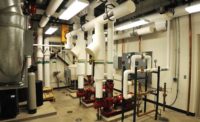
A retrofit resulting in new boilers, burners, and controls at this 4 million-sq-ft U.S. government campus made a significant impact on a facility energy expenditures and missions. Additionally, the retrofit is on track to pay back within four to five years, depending on weather.
Sprawling over 4 million sq ft and hosting more than 7,000 employees of the Department of the Interior and other federal agencies, the campus of the Denver Federal Center (DFC) has significant heating needs.
Trying to meet those needs efficiently has been an ongoing challenge. In the early 1990s, the DFC replaced a central steam plant with satellite boilers and installed boilers that were inefficient compared to current standards and lacked emissions reduction measures. The boilers heated hot water even when it wasn’t necessary. They also cost the U.S. General Services Administration (GSA) about $100,000 in refractory repairs over a two-year period. On top of all that, the boilers hadn’t been regulated for the elevation, which meant they would never meet the maximum efficiency ratings.
A Mandated Solution
If efficiency was already a problem for the facility founded in 1942 as the Remington Arms Factory, it became an even bigger issue with the passage of the Energy Policy Act of 2005, which required federal agencies to reduce their annual energy consumption by 2%. A subsequent Executive Order (EO 13423) from President Bush, published in 2007, upped the ante to an annual 3% reduction.In the summer of 2006, a DFC project team including Charlie Carruth, Charlie Rienhardt, and Amy Lineberry from GSA; Doug Baughman, the DFC building manager; and Doug Rothgeb P.E., C.E.M., a part of Siemens Government Services, working for the GSA, began planning to meet the challenge. Their energy reduction plan called for replacing 20 old boilers with state-of-the-art, ultra-low-emission and high-efficiency boilers. The project scope also included retrofitting new high-efficiency burners on boilers in three buildings where replacement wasn’t practical.
Based on GSA’s research and discussions with several industry boiler companies, the team selected Denver-area boiler representative Thomas B. Mansfield Co., a member of the Cleaver-Brooks Representatives Association, to provide the products and services needed to meet GSA’s goals. Mansfield called in Dan Willems, vice president of product development for boiler systems manufacturer Cleaver-Brooks, who showed the DFC team the high-efficiency new technology that Cleaver-Brooks could deliver.
Cleaver-Brooks was selected to provide the high-tech boilers, burners, and advanced controls, including 20 ppm low-NOx condensing hot water boiler systems and 30 ppm low-NOx steam boiler systems ranging from 40 to 200 hp. “The new boilers reduced the DFC natural gas consumption efficiency by 21% compared to campus data from the previous winter season. And this reduction happened in a year that was much colder,” said Rothgeb.
Bigger Efficiency, Smaller Footprints
The new systems were fully integrated with the facility’s centralized Environmental Management System. The new ClearFire boilers in the new configuration were considerably more compact than the existing units. In one building, three large boilers were replaced by one small ClearFire, which operates faster, more effectively, and more efficiently.“The new boilers performed even better than expected. I was very impressed with the boiler system technology,” said Rienhardt. “I really like the new link-less, high-efficiency burners, as well as the new low-water cutout technology.”
The high turn-down burners selected have helped the DFC to reduce fuel consumption and greenhouse emissions during moderate weather, when less heating is required. It is estimated that the changes will result in annual emission reductions of 22,314,150 lb of CO2; 180,082 lb of SO2; and 26,299 lb of NOx, with corresponding life cycle emission reductions.
The ability to operate the boilers only when necessary also means that the DFC can supply precise heating to labs that required tighter temperature parameters. Maintenance costs and water consumption were also dramatically reduced, including a projected savings of tens of thousands of dollars through the elimination of refractory repairs, according to Cleaver-Brooks. The GSA was also able to recycle 66.56 tons of steel from the replaced boilers.
The potential impact on a facility energy expenditures and emissions is significant. Not only has the $2 million project improved efficiency and met federal mandates; it’s also on track to pay back within four to five years, depending on the weather.ES


